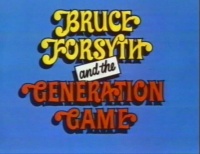The Generation Game
(→Videos) |
m (→Broadcast) |
||
| Line 39: | Line 39: | ||
== Broadcast == | == Broadcast == | ||
| - | BBC 1, | + | BBC 1, 2 October 1971 to 3 January 1982 (198 episodes)http://www.ukgameshows.com/p/index.php?title=The_Generation_Game&action=edit§ion=3 |
| - | + | ||
| - | BBC 1 ( | + | BBC 1, 7 September 1990 to 13 April 2002 (215 episodes) |
| - | Splash Media for BBC Worldwide and UKTV Gold, ''The Generation Game: Now and Then'' ( | + | BBC 1 (''Generation Fame'' one-off), 31 December 2005 |
| + | |||
| + | Splash Media for BBC Worldwide and UKTV Gold, ''The Generation Game: Now and Then'' (22 November - 13 December 2007, 4 episodes) | ||
</div> | </div> | ||
Revision as of 11:42, 9 September 2010
Contents |
Host
Bruce Forsyth (original host)
Roy Castle (stand-in host, 29 November 1975)
Bruce Forsyth (2nd time)
Jim Davidson (stand-in for 2 episodes in 1994, then regularly from 1995 to 2002)
Paul O'Grady (pilot, unaired)
Graham Norton (Generation Fame)
Bruce Forsyth (3rd time, Now and Then)
Co-hosts
Hostesses: Anthea Redfern
Isla St Clair
Rosemarie Ford (1990-1994)
Sally Meen (1995)
Melanie Stace (1996-2000)
Francine Lewis (1998-1999)
Lea Kristensen (2001-2002)
Stefania Aleksander (2007)
Broadcast
BBC 1, 2 October 1971 to 3 January 1982 (198 episodes)http://www.ukgameshows.com/p/index.php?title=The_Generation_Game&action=edit§ion=3
BBC 1, 7 September 1990 to 13 April 2002 (215 episodes)
BBC 1 (Generation Fame one-off), 31 December 2005
Splash Media for BBC Worldwide and UKTV Gold, The Generation Game: Now and Then (22 November - 13 December 2007, 4 episodes)
Synopsis
The Generation Game involved four couples where the two members of each team were a generation apart (hence the 'generation' bit of 'The Generation Game'). The four couples split into two sets of two couples who faced off against each other. The winners faced each other in the final and the winners of the final played the conveyor belt game (did we go a bit fast for you there?)
The games themselves relied on the hilarity that normal people are rubbish at anything remotely difficult. An expert demonstrated how to do something, say modelling something using a potter's wheel or wallpapering an overhang or dressing up a shop window then the players tried to emulate the feat, usually in less time than the expert took.
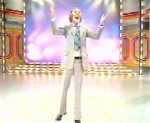 Original host Bruce Forsyth welcomes his audience
Original host Bruce Forsyth welcomes his audienceAfter watching the contestants make complete fools of themselves for a few minutes, they brung the expert back in to judge their efforts. Most games involved the players in the teams playing separately so each team got two marks out of ten which was added together to make the score for that round. Funnily enough, you could do really badly but would still get a mark just as high as somebody who was actually far better 'just for trying', which was nice.
After two rounds, the team with the highest score went through to the final whilst the losing team were sent home - with a Quivvering Bloke as a consolation prize in Davidson's version.
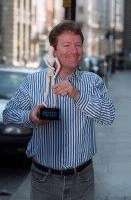 Jim Davidson and "quivvering bloke"
Jim Davidson and "quivvering bloke"After being put through the rigmarole again, the finalists usually did some major dance or acting role with the added hilarity of the players not being able to read very well so the lines came out all wrong. These pieces would usually involve someone quite famous too who in olden days would have marked each team but by the end the winners were decided by the democracy of the audience vote. That's New Labour for you.
The winners then played The Conveyor Belt game where they had to remember as many of the twenty objects that passed in front of them as they possibly could - one of which would be the infamous giant cuddly toy. All together now - "Aaaahh!". For each one they could recall (or were blatantly reminded by the hosting at the time) they won that prize. In the Forsyth years they also had Brucie Bonuses, seemingly worthless objects which if recalled were opened up to reveal a holiday. In Davidson's tenure they had to remember 15 out of 20 to win the holiday.
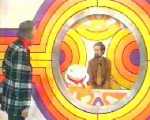 The conveyor belt game. Did they really use colours like that in the 1970s?
The conveyor belt game. Did they really use colours like that in the 1970s?The show had quite an interesting lineage with regards to hosts.
Way back in the mists of time old Brucie boy hosted with co-host, and (at the time) wife Anthea 'Teeth' Redfern. He regularly asked her to 'Give us a twirl', she replied 'Cadbury's haven't invented them yet' (not really). He also sang the show's theme tune (see below). Of course, when he sang "Life is the name of the game" which is wrong of course, since The Generation Game was the name of the game. With inaccuracies like that it's no wonder he left.
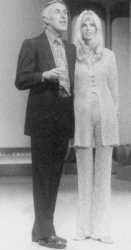 Bruce Forsyth and Anthea Redfern
Bruce Forsyth and Anthea RedfernHe was replaced by Larry 'Camp' Grayson with Isla St Clair. Larry Grayson was camp, there's no denying that. His catchphrase was "Shut That Door" and he was a popular host. He didn't try to be Brucie and he did this by having his own style. As well as camping it up, he constantly gave the impression that he didn't know quite what he was supposed to be doing or even where he was meant to stand, but this was mostly put on - and the audience and viewers loved it, especially when he tried out the games himself and inevitably made a complete hash of it - which Brucie rarely, if ever, did. But even when Larry did get himself in a jam, Isla St Clair was always there to get him out of it - the two had an excellent rapport with much amusing banter - and she also took on the role of explaining the games. Grayson also asked "What are the Scores on the Doors, Isla?" but Jim Morrison was unavailable for comment.
Then shock of shocks, it ended.
Then the BBC bought it back! With Brucie as host! With the original theme tune! With Rosemarie 'Who?' Ford! Perhaps it was a testament to the format or the choice of hosts that the updated versions still managed to pull in a reasonable amount of viewers. Yup, Brucie was back and stayed for another four years, and didn't he do well? Friday nights with this and Challenge Anneka had the BBC basking in a blaze of glory.
Near the end of the Brucie run, for one reason or another Jim Davidson stood in for an episode. He proved so popular (apparently) that when Brucie left he did it full time. Rosemarie Ford left and in came Sally 'GMTV' Meen who smiled a lot but didn't really gel into the format. However, the theatrically trained Melanie Stace was then drafted in to the show's line up.
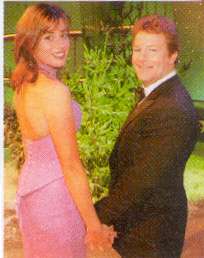 Jim Davidson and Melanie Stace in a publicity photo for a Christmas show
Jim Davidson and Melanie Stace in a publicity photo for a Christmas showThe final hostess - Lea Kristensen - may have been familiar to regular game show viewers as one of the models on Bruce's The Price is Right. Jim met her at the Harry Ramsden's fish and chip bar in Heathrow Airport and it was "love at first sight". Who says romance is dead?
By that time of course the show was all modern and tacky and family orientated. There were plenty of laughs (sorry, we meant "plenty of gunge"), more emphasis on contestants making fools of themselves and appearances of special guests, a veritable "Who's That?" of past-it celebs. In some ways, the new-style series wanted to be Tiswas pure and simple, except not nearly as good and by that time we preferred watching Blind Date anyway, so nerrrr. To be fair, Davidson did a reasonably good job as stand-in host in 1994 when Brucie was off, but then, if he'd tried to introduce his own style at that time, he (Davidson) would certainly have come off second-best in any comparisons between the two hosts. A shame then that he did build up his own style when he took over full-time and that it proved to be the beginning of the end of the show.
Although it had a few dodgy patches, this was one of the best-loved and longest-lasting UK variety formats of all time, and finally ended in 2002 after getting thrashed in the ratings by Pop Idol. Didn't it do well?
Now and Then
In 2007, UKTV Gold briefly revived the format, with Forsyth back in charge, fronting a mixture of classic archive clips, guest celebrities, and a previous runner-up playing the conveyor belt.
Key moments
A guaranteed mass nervous breakdown from the audience every single week when Brucie (hosting at his absolute Bruciest) inevitably decreed "Ohh! Didn't they do well?".
Catchphrases
Bruce Forsyth: His famous "Good game, good game!" catchphrase was often used after a really bad game - Forsyth used it to generate applause from the audience so that it gave him time to get the contestants back to the front of the stage. Other catchphrases included: "Nice to see you, to see you, nice!", "Let's meet the eight who are going to generate!", "Give us a twirl, Anthea", "Let's take a look at the old scoreboard", "What's on the board, Miss Ford?", "Didn't they do well?!", "Our contestants have no idea what's coming up, they have not rehearsed, this... is their... rehearsal", "That's all there is to it!" "And on the conveyor belt tonight..." "Keep thinking nice thoughts", "Our first game is called (whatever) - but first of all, feast your eyes on these!" and "See you next week - be there!"
Larry Grayson: "Shut that door!", "What are the scores on the doors, Isla?" or, "Isla, can we have the scores on the doors, please?" (in later series, this changed to "the awards on the boards"), "What a gay day!", "Look at all the muck in 'ere!", "Who is the guest behind the door tonight?" and so forth. And instead of "Didn't they do well" it was "What a lot you got!"
Jim Davidson: No real catchphrases as such, but lots of bizarrely out-of-place catchgunge. (Actually, he did have one catchphrase in the early days - "What's on the screen, Miss Meen?" but this didn't last long, because Sally Meen only stayed for one series).
Isla St Clair (in response to Larry's request for 'the scores on the doors'): "And the names on the frames say ...."
Inventor
Based on the Dutch show (Een Van De Aacht - literally, One Out of Eight) that was part game, part chat show. They dropped the chat for the Brit format. In fact, they dropped just about everything except the conveyor belt at the end.
Theme music
The best remembered version of the theme music was sung by Bruce Forsyth himself, and begins thus:
Life is the name of the game,
And I wanna play the game with you.
Life can be terribly tame,
If you don't play the game with two.
Yeah life is a go-as-you-please
And I need some place to go with you.
Life can be oh-such-a-tease,
If you don't play the game with two.
Trivia
Bruce met hostess Anthea Redfern at a Miss Lovely Legs competition - she later became his second wife.
An anagram of Bruce Forsyth's Generation Game is Embarrassing Ego of the Century.
For all Brucie's slickness on the show, he was occasionally caught on the hop. Two such incidences occurred during his 90's version of the show: on one occasion, he said 'decapinated' instead of 'decapitated' and the late Ned Sherrin, who was judging the game concerned, pulled him up on that. The other occasion was when the contestants were having to impersonate various celebrities, as demonstrated by Allan Stewart. One of the celebrities they had to impersonate was Bruce himself: Bruce said afterwards, "I thought the Bruce Forsyth bit was a bit cruel" and Stewart responded, "No, they did very well there - in fact, I thought the worst Bruce...was you Bruce!" much to Bruce's (mild) indignation.
One episode was watched by 23.9 million viewers during the 1979 ITV strike, making it the highest ever rating for a UK game show.
The Generation Game was unsuccessfully piloted in the USA as A Piece of Cake, with Forsyth as host.
Jimmy Tarbuck was offered the host's job when Larry Grayson left, but turned it down to do Live At Her Majesty's for ITV instead.
Two "Blue Peter" presenters, John Noakes and Lesley Judd, took part in a rehearsal for the show on one occasion in the mid-70's - and they won, with Noakes being the one to go through the conveyor belt game (not that he took the prizes home, of course - they had to go back on the belt for the real contestants later on). Apparently, Bruce paid them both a big compliment at the end by turning to Anthea and the crew and saying, "Didn't they do well?" and they felt that he really meant it, too. One other notable point here is that Judd mentioned that the conveyor belt required several men to place the prizes on the belt and several more to take them off, all well within earshot, making it very difficult for contestants to remember things. Plus, they'd have Bruce (or Larry) constantly chipping in behind them, not to mention the audience shouting things out, so, all in all, it was little short of a miracle that the contestants managed to remember as many prizes as they generally did.
The man responsible for commissioning the series in the UK was the BBC's legendary Head of Light Entertainment at the time, the late Bill Cotton. Cotton once revealed that the first-ever show was so disastrously bad that he and his team decided not to broadcast it. Instead, they broadcast the far better pilot show, the only problem being that the pilot was far longer than the allocated transmission-slot, so they had to do a quick last-minute edit, meaning that the scoring ended up making no sense at all, but not one viewer wrote or phoned in to complain. What was more, the pilot proved so popular that the series' future was assured and Cotton and his team duly ensured that all subsequent shows were made in the style of the pilot rather than that of the hopeless first edition.
Merchandise
A Bruce Forsyth's Generation Game book was published in 1992.
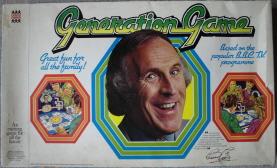 In 1975, Strawberry Fayre and Denys Fisher published a board game featuring a three-dimensional diorama of the set, a working countdown clock and the famous sliding doors.
In 1975, Strawberry Fayre and Denys Fisher published a board game featuring a three-dimensional diorama of the set, a working countdown clock and the famous sliding doors.Web links
Nostalgia Central's Generation Game page
Videos
Pictures
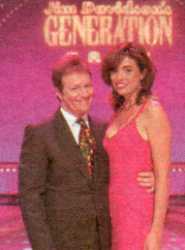 Jim Davidson and Melanie Stace.
Jim Davidson and Melanie Stace.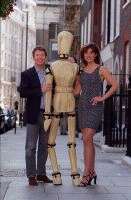 Jim Davidson and Melanie Stace with a giant version of the "quivvering bloke" which seemed to be a modern mascot for the show.
Jim Davidson and Melanie Stace with a giant version of the "quivvering bloke" which seemed to be a modern mascot for the show.See also
Weaver's Week review of 1973 edition

